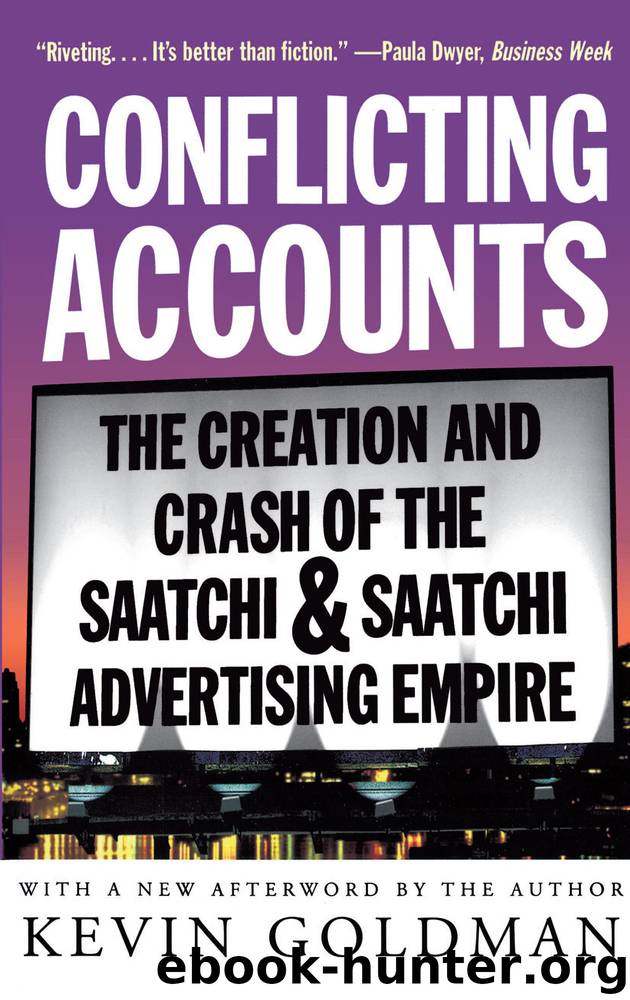Conflicting Accounts by Kevin Goldman

Author:Kevin Goldman
Language: eng
Format: epub
Publisher: Simon & Schuster
• • •
DUSTUPS INVOLVING INDIVIDUALS considered inconsequential to the future of the organization, such as Spielvogel, did not concern Maurice Saatchi, who now had to work if he wanted his large payday. And, according to his associates, he did work. “The rainmaker was making it rain,” Jeremy Sinclair said. “Maurice was reenergizing the business. The carrot was attractive.” In fact, Sinclair said he received a note from Herro in August 1994 thanking him for his efforts and noting that things seemed to be improving. Sinclair, not one to miss an opportunity to lobby for Saatchi, replied to Herro and agreed that events had taken a turn for the better, “but we’ll need your help to get the [share option scheme] through.”
Scott remarked publicly that he now had a “fantastic” relationship with Saatchi. “I have worse disagreements with my wife … and I’ve only been married four weeks.”
In May 1994, Saatchi & Saatchi Advertising in London won the £35 million Camelot Group account for the United Kingdom’s first National Lottery. It was believed to be the United Kingdom’s biggest account for a single product. It brightened an otherwise gloomy new business record for Charlotte Street and Saatchi loyalists immediately seized on it as an opportunity to credit the recent infusion of Maurice Saatchi.
The summer continued on an upbeat note, even though by then Saatchi & Saatchi Company PLC had slipped to the fifth-largest ad group in the world with annual billings of $6.5 billion; between June 9 and August 8, the Saatchi & Saatchi share price rose 31 percent to 176 pence from 142 pence. Newspapers called the much-improved interim profits for the company the first peace dividend. Margins were improving as well during 1994, to 5.7 percent from 4.7 percent, although Charlie Scott said he would not be satisifed until margins were 10 percent. The outlook remained poor in the United States in 1994, however, with revenue falling to £159.1 million from £179.5 million; operating profits in America fell to £6.1 million from £10.7 million. By August, Saatchi & Saatchi had seen its American Depositary Receipts plummet from a peak of 343 in 1987 to 7Ve, a 98 percent drop in value.
Bates also won several coveted new pieces of business. One was Warner-Lambert, which had once fired Bates. The other account win would have reverberations for the holding company and both agencies. In August, Compaq computer selected Bates Europe to handle its account, valued at £33 million, for Europe, the Middle East, and Africa.
Some periodicals incorrectly credited the win to Saatchi & Saatchi; after all, Bates is owned by Saatchi & Saatchi Company PLC, so the mistake was understandable. However, Saatchi & Saatchi Advertising was the agency for Hewlett-Packard, a Compaq rival. This was a lose-lose scenario: Bates was upset because it won the account and did not receive the proper credit; Compaq was upset because its selection was ignored; Saatchi & Saatchi Advertising was upset because it did not want the credit; and Hewlett-Packard was upset because its agency was now incorrectly identified as the Compaq agency.
Download
This site does not store any files on its server. We only index and link to content provided by other sites. Please contact the content providers to delete copyright contents if any and email us, we'll remove relevant links or contents immediately.
| Advertising | Consumer Behavior |
| Customer Service | Marketing |
| Public Relations | Sales & Selling |
| Search Engine Optimization |
Influence: The Psychology of Persuasion by Robert B. Cialdini(4715)
The Miracle Morning by Hal Elrod(4637)
The Hacking of the American Mind by Robert H. Lustig(4318)
Pre-Suasion: A Revolutionary Way to Influence and Persuade by Robert Cialdini(4145)
Unlabel: Selling You Without Selling Out by Marc Ecko(3587)
Ogilvy on Advertising by David Ogilvy(3508)
Hidden Persuasion: 33 psychological influence techniques in advertising by Marc Andrews & Matthijs van Leeuwen & Rick van Baaren(3472)
Purple Cow by Seth Godin(3139)
Who Can You Trust? by Rachel Botsman(3087)
Kick Ass in College: Highest Rated "How to Study in College" Book | 77 Ninja Study Skills Tips and Career Strategies | Motivational for College Students: A Guerrilla Guide to College Success by Fox Gunnar(3075)
The Marketing Plan Handbook: Develop Big-Picture Marketing Plans for Pennies on the Dollar by Robert W. Bly(2975)
This Is Marketing by Seth Godin(2971)
I Live in the Future & Here's How It Works by Nick Bilton(2935)
The Power of Broke by Daymond John(2897)
Building a StoryBrand by Donald Miller(2841)
The Tipping Point by Malcolm Gladwell(2827)
The 46 Rules of Genius: An Innovator's Guide to Creativity (Voices That Matter) by Marty Neumeier(2796)
Draw to Win: A Crash Course on How to Lead, Sell, and Innovate With Your Visual Mind by Dan Roam(2734)
Market Wizards by Jack D. Schwager(2643)
